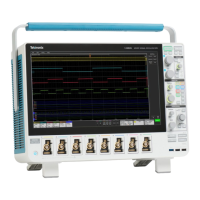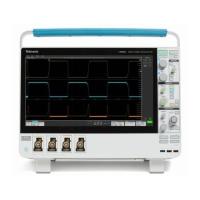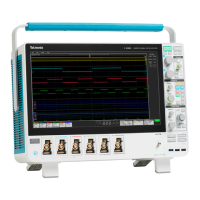Command groups
Waveform T ran
sfer command group
Use the commands in the Waveform Transfer Command Group to transfer
waveform data points from the instrument. Waveform data points are a collection
of values tha
tdefine a waveform. One data value usually represents one data point
in the waveform record. When working with envelope waveforms, each data
value is either the minimum or maximum of a min/max pair.
Before you transfer waveform data, you must specify the data format, record
length, and waveform source.
Data formats. Acquired waveform data uses eight or more bits to represent each
data point. The number of bits used depends on the acquisition mode specified
when you
acquired the data. Data acquired in SAMple or ENVelope mode uses
eight bits per waveform data point. Data a cquired in AVERage mode uses up to
14 bits per point.
The instrument can transfer waveform data in either ASCII or binary format.
You specify the format with the DATa:ENCdg command. The instrument uses
signed, 4 byte integers and floating point values; it does not support unsigned
floating point values.
ASCII data is represented by signed integer or floating point values. An example
ASCII waveform data s tring can look like this:
CURVE<space>-110,-109,-110,-110,-109,-107,
-109,-107,-106,-105,-103,-100,-97,-90,-84,-80
Use ASCII to obtain more readable and easier to format output than binary.
However, ASCII can require more bytes to send the same values than it does with
binary. This can reduce transmission speeds.
Binary data can be represented by signed integer or floating point values. The
range of the values depends on the byte width specified. When the byte width is
o
ne, signed integer data ranges from -128 to 127, and positive integer values
range from 0 to 255. When the byte width is two, the values range from -32768 to
32767. When a MATH (or REF that came from a MATH) is used, 32-bit floating
point values are used that are four bytes in width.
2-88 MSO54, MSO56, MSO58, MSO58LP Programmer

